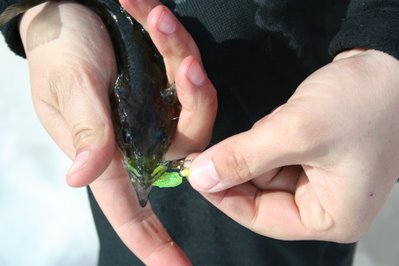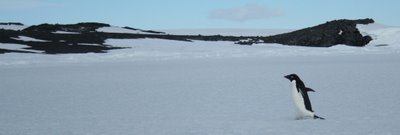What a difference two months makes! The ice runway is closed, its surface slushy and its depth perhaps insufficient for the landing of aircraft. The surface of the flagged route across the ice was melting and pitted with pools of water of indeterminate depth. Like New York City potholes after a rainstorm, it is difficult to tell whether you can drive right over them or if they dip deeply down towards the water below. It is one thing to sit comfortably driving a Pisten Bully, which must weigh a ton or so, over the frozen sea in subzero temperatures, with the heat blasting, and quite another to find oneself dodging puddles in a steamy, tropical fifty plus degrees F. With the sweaters stripped off and the windows wide open and the sun beating through the windshield it became all to easy to imagine the ungainly Bully sliding into an advancing melt-crack and sinking very rapidly to the bottom of the Ross Sea.
We passed one recumbant sausage-like Weddell seal after another, their enormous tubular bodies stretched out beside pressure ridges where, we knew, cracks must exist big enough to give the mighty mammals access to the water and its fish. It was lovely and hot and, as Gretchen the fearless fisherwoman put it, "a great day for taking the vehicles swimming."
 Jessie, Gretchen and some dude named Tim jigging for "bernies" (Trematomus bernacchii)
Jessie, Gretchen and some dude named Tim jigging for "bernies" (Trematomus bernacchii)When we arrived at Cape Evans, Gretchen and her posse were reclining on their "tomato" shelter, basking in the sun and fishing with notably less intensity than on our previous visit so many weeks ago. Jess caught a rare and strangely beaked Dragonfish.
 The dragonfish has a curious beak: Jessie on the catch and release
The dragonfish has a curious beak: Jessie on the catch and releaseAs we interviewed Gretchen about Antarctica's meaning in her life, she spied two Adelie Penguins waddling towards us across the ice. This brought an immediate end to the interview, as I have an "emergency penguin observation work-stoppage" clause in my contract. We walked out to meet them, flapping our arms like flippers and then lying down on the ice when they were about 100 meters off. Very curious, and without surface-based predators, they continued towards us to have a look. Gretchen pointed out that they are the only other family of birds besides parrots who manipulate the feathers of their crown and nape to change the shape of their heads to suit, perhaps, their mood. This was a piece of ornithological trivia unknown to me, a lifelong birder. We were soon able to see this behavior displayed.


The penguins continued, heading directly towards Scott's hut, as if they intended to visit its relics, and then continued past it onto an expanse of black volcanic rock. Here, perhaps lulled by the surface heat, they collapsed for a nap.
 Erebus, pond, and a smattering of skuas
Erebus, pond, and a smattering of skuas
Nearby, the same passive solar gain of this black rock had created a pond, in which 15-20 skuas were splashing and washing and carrying on. Extraordinarily aggressive large gull-like marauders, they feed on the few delicacies the Antarctic ecosystem has to offer: penguin chicks and eggs, seal placentas and dead seals, fish scraps from Gretchen's bait pot and candy bars stolen from the hands of hapless McMurdoites crossing from the dining hall to the dorms.
 Catharacta maccormicki, The South Polar skua. Note the pale nuchal collar, characteristic of this species.
Catharacta maccormicki, The South Polar skua. Note the pale nuchal collar, characteristic of this species.
No comments:
Post a Comment